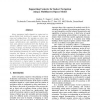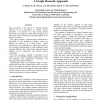34 search results - page 2 / 7 » eSLAM - Self Localisation and Mapping Using Embodied Data |
MDM
2009
Springer
14 years 4 days ago
2009
Springer
Indoor navigation highly depends on context and requires flexible data structures to support the many use cases and configurations. For example, an indoor navigation system must c...
HICSS
1997
IEEE
1997
IEEE
Retaining Body Language in Subjective Virtual Environments Using Artifact-Centred Coordinate Systems
13 years 9 months ago
Embodiment and subjectivity are important research issues for collaborative virtual environments. We claim that the direction and distance of an embodiment are the most important ...
ICRA
2000
IEEE
13 years 10 months ago
2000
IEEE
Data association is the process of relating features observed in the environment to features viewed previously or to features in a map. Correct feature association is essential fo...
RAS
2007
13 years 5 months ago
2007
This paper presents Scan-SLAM, a new generalisation of simultaneous localisation and mapping (SLAM). SLAM implementations based on extended Kalman filter (EKF) data fusion have t...
IROS
2008
IEEE
13 years 12 months ago
2008
IEEE
— Building an accurate three dimensional map is an important task for autonomous localisation and navigation. In a sequential approach to reconstruction from video streams, we sh...


